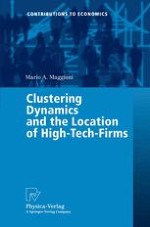2002 | OriginalPaper | Buchkapitel
What do we know about the clustering of high-tech firms?
verfasst von : Professor Mario A. Maggioni
Erschienen in: Clustering Dynamics and the Location of High-Tech-Firms
Verlag: Physica-Verlag HD
Enthalten in: Professional Book Archive
Aktivieren Sie unsere intelligente Suche, um passende Fachinhalte oder Patente zu finden.
Wählen Sie Textabschnitte aus um mit Künstlicher Intelligenz passenden Patente zu finden. powered by
Markieren Sie Textabschnitte, um KI-gestützt weitere passende Inhalte zu finden. powered by
From a theoretical viewpoint, when observing the spatial distribution of a phenomenon (say the location of firms) in a given territory (say a nation or a region), three main structures can emerge: clustering (i.e. most firms tend to concentrate in a single or in a few locations), avoidance (i.e. all firms tend to be uniformly scattered, in order to maximise inter-firm distances) and independence (i.e. no clear spatial pattern is visible, locations are as if determined by a random process). A specific branch of statistics is devoted to the identification of specific patterns of distributions of events over a plane which can be tested against the null hypothesis of “complete spatial randomness”. Such an hypothesis implies (i) that the intensity of events (in our case firms’ locations) does not vary over the plane and (ii) that there are no interactions among events. It is easy to see that the location of firms does violate both hypotheses since (i) there are considerable variations in the spatial distribution of firms and (ii) the previous location of firms at a given site is likely to influence (in various ways, both positively and negatively) the location of other firms in the same and in neighbouring areas.
